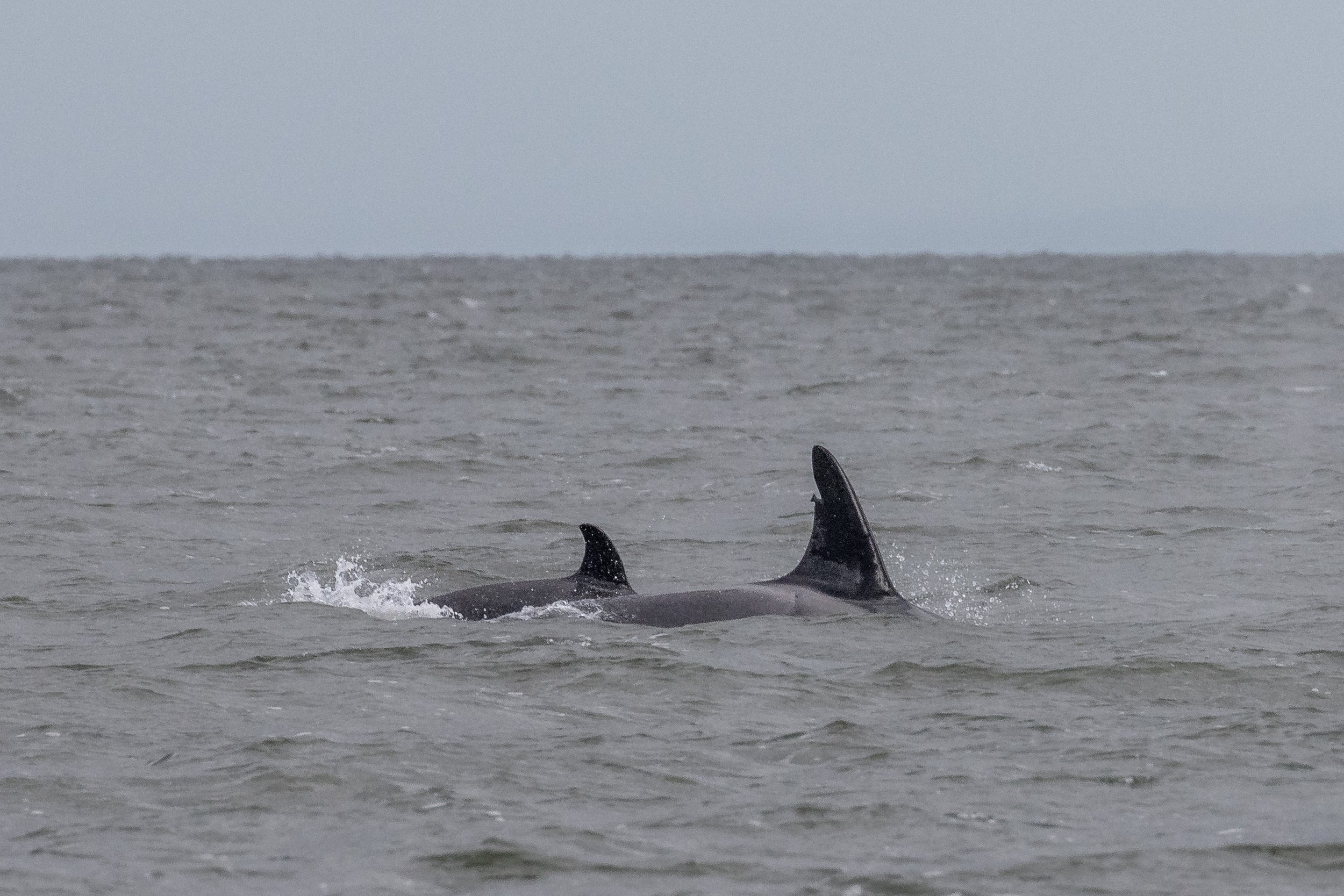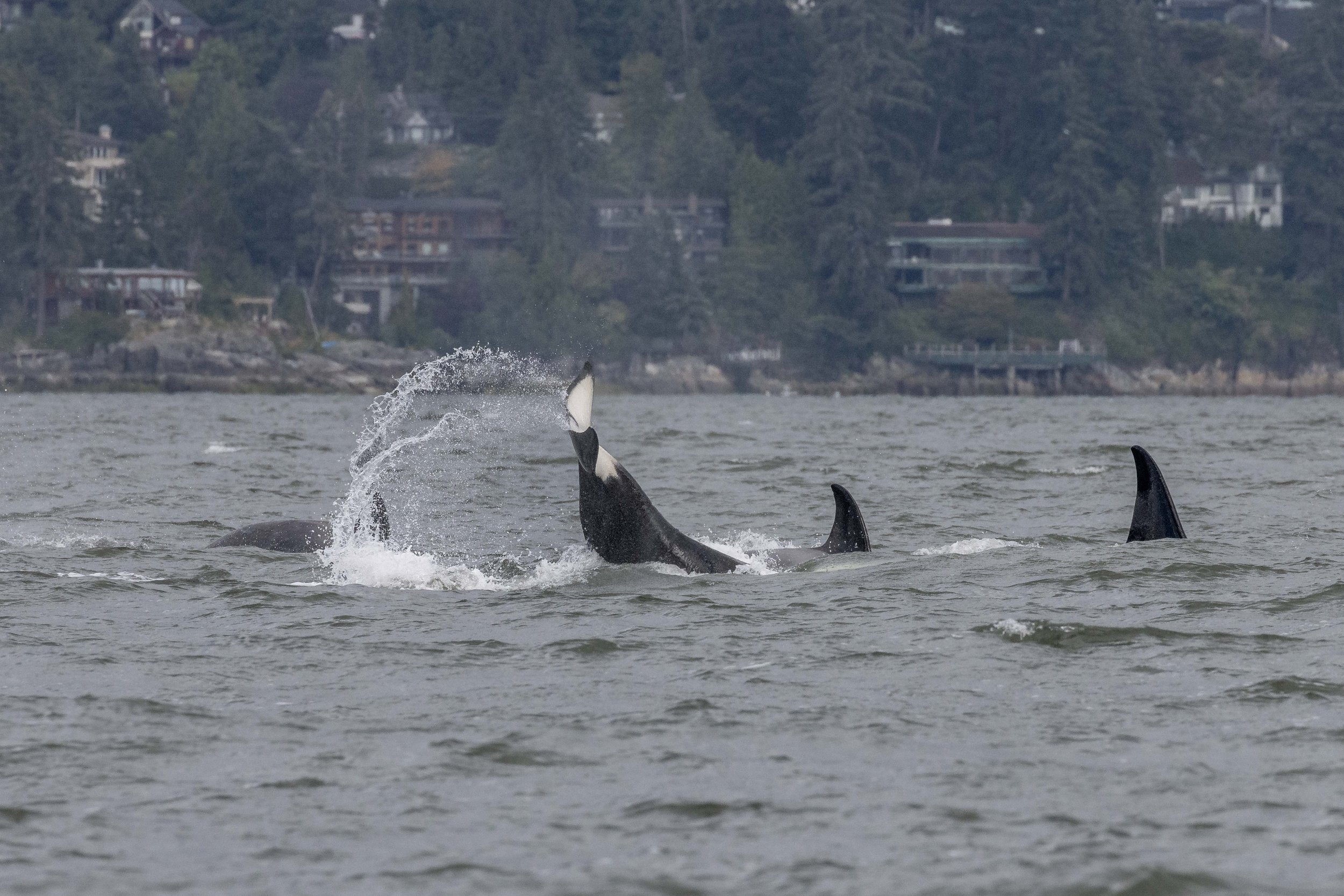June 14, 2024, 3:30 PM - Orca overload and a lunge-feeding humpback
Our open boat Cascadia left the dock this afternoon in search of whales. After a bit of looking, we ended up finding a large group of killer whales in Howe Sound. Large groups of Transient Killer Whales like these are called “T-Parties”. It’s always fun to see who hangs out with who. Today’s T-Party contained orcas from five different matrilines! Among them was T087 Harbeson, the oldest male killer whale in British Columbia. Male killer whale life expectancy is about 30 years old, with some living to 50. Harbeson is 62 years old! We also had a couple of calves who are less than a year old.
T036 Flapjack ♀ (≤1970)
T036B Tattertip ♀ (1998)
T036B1 Bhotia ♀ (2009)
T036B2 Greenfelder ♀ (2013)
T036B4 (2024)
T071B1 Zengo ♀ (2013)
T071B2 Tasli/Nemo ♂ (2018)
T086A3 Tyndall ♀ (2011)
T086A3A (2024)
T087 Harbeson ♂ (~1962)
T123 Sidney ♀ (~1985)
T123A Stanley ♂ (2000)
T123C Lucky ♀ (2012)
T123D Darcy ♀ (2018)
It was clear to see where the “Party” in the term “T-Party” comes from today, as the group was displaying a whole host of exciting behaviour including tail-slapping, pec-slapping and breaching! The “T” in “T-Party” refers to the parties being made up of the “Transient” ecotype of killer whales.
Back in the 1970s when killer whale researcher Michael Bigg started photographing these whales and identifying them, he noted that there were two different types in the inside channels. One of them ate primarily fish and would frequent a specific range during the summer. The other ate primarily marine mammals such as seals, sea lions, and porpoises. They would also come and go and there was no pattern to it. The latter Bigg called “Transients”, and the fish-eaters he called “Residents”. After doing some genetic research, it was found that Residents diverged from Transients around 700,000 years ago. The differences between the two are so distinct that scientists recently proposed the idea of designating them as two separate species.
After our time celebrating with the orca was up, we headed out of Howe Sound, into the Strait of Georgia where we came across a Humpback Whale. This whale was demonstrating lunge-feeding behaviour, which involves accelerating through the water with their mouth open in order to trap small prey items within. This method of feeding means our whale didn’t need to dive very deep, so they weren’t arching their back and lifting their tail out of the water which they do before heading deeper into the water column. We typically use the unique markings on the underside of a humpback’s tail flukes to identify individuals, so this whale remains a mystery to us!
Humpback Whales migrate to BC from their breeding grounds in Hawaii, Mexico and Central America where there isn’t much in the way of food. This means they’re usually hungry when they reach us and can spend up to 22 hours of the day feeding. After our glimpse into this humpback’s daily feeding activity, we made our way back to Nanaimo. It’s always great when we get to see both orca and humpbacks on a tour as we can really appreciate the differences between the whales within our waters.
Please enjoy the photos from this tour, taken by Marine Naturalist Val Watson.
T087 Harbeson.
T123A Stanley, T071B1 Zengo, T123 Sidney, T086A3 Tyndall and the face of another just about to surface.
T071B2 Nemo/Tasli behind his sister T071B1 Zengo.
T123C Lucky and T123 Sidney.
T123A Stanley with T086A3 Tyndall ahead of him.
T123A Stanley beside his mother T123 Sidney. The males dorsal fin can reach around 6 feet high whereas the females stay around 3 feet.
T123A Stanley.
T086A3 Tyndall beside another with a third waving their tail behind them.
T123 Sidney, T123C Lucky, and T123A Stanley.
T123A Stanley, T123C Lucky, and T071B2 Nemo/Tasli.
T071B2 Nemo/Tasli, T086A3A (little nose at the surface), T086A3 Tyndall, T123C Lucky, and T123A Stanley.
The T071B siblings - T071B1 Zengo and T071B2 Nemo/Tasli. Nemo got his nickname as he’s missing a pectoral fin!
T123A Stanley.
T086A3 Tyndall with her little calf T086A3A beside her.
T036 Flapjack.
T071B2 Nemo/Tasli, T123 Sidney.
Someone was excited and tailslapped away! T123D Darcy and T123 Sidney beside and ahead of them.
T123A Stanley.
Sneaky little T036B1 Bhotia.
T123A Stanley.
This whale’s fluke has some deep scarring on it.
Look at that little nose!
T036B Tattertip with T123A Stanley coming towards the camera.
Flukes up!
A rainbow!
Our mysterious Humpback Whale.
The dorsal fin on our humpbacks is significantly smaller than the orca.
Our Humpback Whale surfacing amongst the waves.




























